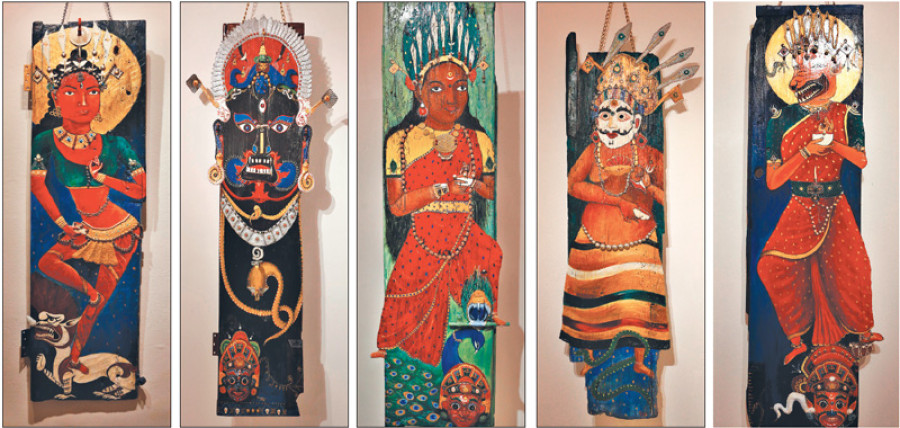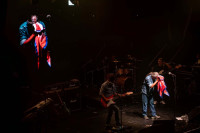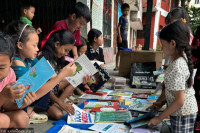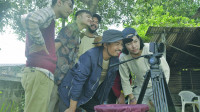Entertainment
Cultural Memory Transformed
My first encounter with the Nava Durga tradition was somewhat unusual. It happened during the staging of Hamlet at the Bhaktapur Durbar Square by the visiting artistes of the Globe Theatre last year.
Kurchi Dasgupta
My first encounter with the Nava Durga tradition was somewhat unusual. It happened during the staging of Hamlet at the Bhaktapur Durbar Square by the visiting artistes of the Globe Theatre last year. The re-creation of Elsinore in earthquake devastated Nepal kept getting interrupted by the insistent beat of drums, cymbals and bells. I later realised that the musical interruptions came from one of the Nava Durga processions taken out annually during the Bada Dashain festival of Bhaktapur.
Nava Durga is an ancient tradition. Possibly more than 200 years old and is marked by the making, worshipping and public presentations (mostly through dances) of a set of ritual masks. Currently ongoing at the Siddhartha Art Gallery is a show of artworks by Meena Kayastha, who has mined this tradition and its iconography to arrive at her own interpretations of femininity and resistance. In the process, she may well be on her way towards reconfiguring the figures of memory or objects that make up our cultural, collective memory.
Divine Debris is Meena’s second solo exhibition of artworks. She works primarily with junk material scavenged and salvaged from junkyards that she then painstakingly crafts into artworks. Divine Debris comprises mostly two dimensional pieces that could sometimes pass off as paintings. But hung as they are, away from the wall, they inhabit a space between painting and sculpture. Yamaraja, Mahakali 1, Brahmayani 1 and Naagkanya are sculptures per se, created in her signature scavenged-material style, and are brilliant examples of her visualising and crafting skills.
Shaken by the earthquakes that reduced parts of her beloved Bhaktapur to rubble, Meena salvaged Newar, handcrafted door leaves from the debris that lay piled everywhere. The doors often came from homes she had known. Onto these she painted her urgent quest for the mythical divinities that had sustained her all her life, who seemed not only to have deserted her but the entire community at a time of catastrophe. The name Divine Debris is telling for many reasons. It gives us a clear indication of what we might expect to encounter at the show. Definitely some ‘divinity’ and some ‘debris’—and we would be right too! For, onto the ancient, salvaged door leaves Meena has affixed found junk (nuts, bolts, burners etc), pristine faux pearls, glittering beads, tiny hand-hewn skulls, pendants, and danglers as embellishment for the painted figures of the protective gods and goddesses of the Nava Durga pantheon. The occasional cupboard key, stopped watch or shovel take your breath away, reveal as they do the artist’s expansive imagination and wit. Papier-mâché augments the found materials in many places. Painted mostly in brilliant primary colours, brushed over with lacquer, the 19 artworks stare us back with a certain stony determination. A determination that no doubt reflects Meena’s relentless search for her own strength and identity as a woman in tradition-imbued (yet globalised) Nepali society. A society in which, the artist feels, women are still ‘considered a gift to be given to someone else’s home.’
It is no coincidence then that Meena should chose the Nava Durga as a vehicle for her quest, since not only are they the divine protectors of her birth city but are also representations of the feminine force (‘sakti’; and ‘durga’ is an incarnation of this very force) in nature according to the tantric tradition. Though ‘nava’ means nine, there are in fact 13 masks that are publicly presented for viewing during the festival. Of the nine, seven deities — Kumari, Varahi, Brahmayani, Maheswori, Vaisnavi, Indrayani and Mahalakshmi—are publicly presented. But Mahakali, the Queen Goddess, who rules over time itself and death, is represented in public as a repousse coin alone since comprehension of her physicality requires an initiate’s intellect. Her secret mask, along with Tripurasundari’s, is preserved out of sight at the ‘dyo-chen’. Therefore it comes as a bit of a surprise when we find two representations of Mahakali in the Divine Debris. The first, a beautifully painted visualisation in which the goddess’s arms (Meena does her homework well and there are the prescribed eight, and her features are in keeping with those in myths and scriptures) spill beyond the door surface through papier-mâché extensions, each holding the requisite implement. Her graceful, bejewelled body rests one foot on a human, her vehicle while her third eye gleams on her forehead. It is significant that not only has Meena taken an esoteric, oral tradition and made it public; she has also made visible a form that has almost always remained invisible. Her imagination has crafted for us a possible, physical face and body for the Mahakali. Another point of interest is that the Nava Durga festival showcases face masks worn by dancers, and the body has never been a part of the traditional picturisation of the deities. Meena has not only given us Mahakali’s face, but a body that inscribes her on our imagination as perhaps the most powerful feminine form. And this she does consistently with each of the other six goddesses (as well as the guardian Duma), endowing them with a desirable physicality that reclaims feminine sexual identity in an unprecedented manner. Mahakali 1 falls back upon Meena’s earlier signature style of found materials and junkyard scrap welded together in a witty, uproarious take on the queen goddess. Fashioned from a discarded lawnmower, chains and levers, the work generates conscious introspection in the viewer about the nature of the truths behind the symbols associated with the goddess. The playing around with material, which can be easily termed profane as it has been collected from dirt-filled junkyards and devastated homesteads, is too significant to pass up here. It stands in striking contrast to the holy, sanctified clay used in ritual Nava Durga mask making. Woven into the agricultural cycle of Bhaktapur, the masks are part of an annually renewed cycle of making and unmaking—they are burned and the ashes stored under water to be reused for next year’s set of masks again.
The remaining six of the 13 traditional masks on the pantheon are of Shiva, Ganesha, Bhairava, Seto Bhairava and the guardians, Sima and Duma. With the exception of Duma, all are male. Meena gives these ample space in her series. Hers is therefore a complete view of the system that recognises that there is no ‘sakti’ without the ‘shiva’, no feminine without the masculine. And though obviously working from an extraordinarily rooted position of feminist strength, she does not bring us a fractured vision. You can’t really clap with one hand (unless it is the zen), can you? Also, Meena models her goddess faces on those that have been close to her and inspired her admiration—her mother, her grandmother, a school principal among others. The personal is enmeshed with the public in her work, making it quite unique. So we have a Maheshwari, the goddess of unity and grace, whose face and posture is modelled on her grandmother’s. But a replica of an original Maheshwari mask is attached near the bottom of the painted surface, opening a space for give and take between tradition and the ‘new’. In fact replicas of the traditional masks are attached to almost each of the deities.
This is of great interest from the perspective of evolving cultural memory. Through the process she is infusing her personal memories and quests into an inherited, passed-on bank of cultural memory. Also, by letting go of the rituals that must accompany their making, the artist has helped secularise an extraordinary ritualistic tradition. Of course masks keep getting made as souvenirs and tourist objects. But Meena’s conscious experiencing and re-presentation of the specific traditions and rituals come across as a self-aware stand and eons away from regular, consumer-oriented manufacturing.
The one deity conspicuous by her absence is Tripurasundari of course, for she is represented by music (the sound of the three musical instruments ‘dyokhin’, ‘taa” and ‘kanhe baja’ played during the processions). Their combined music not only provides the beat for dancers, but heals and protects the neighbourhood. A belief Meena grew up with, and went in search of. It was also the sound that movingly introduced me to the Nava Durga myth.
Here I have touched upon only a few layers that Meena Kayastha’s work embodies. It would be easy to dismiss her effort as irreverent or cynical. In reality, it stand exactly at the opposite pole —the empathy and celebration that she brings to each of the images, the loving care to iconographic details that she invests in each is proof enough of her deep connections to this tradition. Most importantly, the Nava Durga masks were traditionally made by male artists. The right used to be passed down through male primogeniture. Times have changed, and am not sure whether this tradition still persists. But I do feel that Meena’s act of creating the representations is also a quiet yet conscious gesture of wresting authority from a male-dominated system. Her imagery and the material she uses make each piece an endless journey for the viewer, into the image’s symbolic qualities and mythic associations. It definitely contributes towards our understanding of the same, at the same time making them more relevant to contemporary viewers than any traditional mask possibly would. Therefore, I feel there is a strong possibility that her works will have the staying power necessary for an object of communicative, temporary memory to pass into the realm of lasting, cultural memory in future.




 15.12°C Kathmandu
15.12°C Kathmandu










